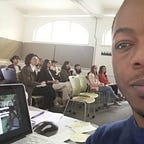Unravelling the power and politics of textiles in art
‘Unravel: The Power and Politics of Textiles in Art’ Opened on 13 February 2024 featuring artists from the 1960s to today who have explored the transformative and subversive potential of textiles. Spanning intimate hand-crafted pieces to large-scale sculptural installations, this exhibition at the Barbican Centre in London brings together over 100 artworks by 50 international practitioners. These include Yinka Shonibare, Cecilia Vicuña, Magdalena Abakanowicz, Tracey Emin, Nicholas Hlobo, Antonio Jose Guzman, and more.
It was an honour to speak with three of these artists, gaining an insight into their respective journeys in textiles. Margarita Cabrera is a Mexican-American artist and activist. Her practice spans smaller textile-based soft sculptures to large community-involved public artworks. Margarita spoke about her work in the show and her practice.
‘I’m grateful to be part of this exhibition with the Space in Between project — a community collaboration that exists in the form of a sewing and embroidery workshops. Immigrant and refugee communities from the Americas have embroidered their border crossing stories with colorful threads on the surface of border patrol fabric. These soft sculptures represent saguaros and prickly pear cacti original to the southwest regions between The US and Mexico — hence the title of the work.
In a welcoming, safe creative space, immigrants build community and deconstruct a border patrol uniform that represents authority, control, and security and through a creative process give shape to new forms — plants that represent nature, health and life. We have been hosting workshops all over the United States since 2010 to explore issues with the intention of naming, exploring and impacting change in support of our immigrant communities. Having Space in Between presented in this UNRAVEL exhibition along with other textile artists proposes a global perspective to the challenge of power structures such as displacement, violence, and systematic racism and helps to creatively reimagine a better world together.’
Acaye Kerunen, is a multidisciplinary performance and installation artist, storyteller, writer, actress and activist based in Kampala, Uganda. Acaye Kerunen (together with Collin Sekajugo) represented Uganda National Pavilion at The 59th International Art Exhibition La Biennale di Venezia 2022. (acayekerunen.com)
‘A very big part of my aesthetic has been re-energising the use of textiles because for a very long time, craft work has been linked to functionality so these are different and because they are women they are geared towards functionality. My direction has always been to exhibit and direct them away from the ground; A liberation and lifting up of the collective voice of the different African women of our culture (in this liberation).’
Mercedes Azpilicueta is a visual and performance artist known for her language-based works who’s vivid tapestry greets you on the entry to the gallery.
There is more thought provoking work by Teresa Margolles’ whose patchwork tapestry has one bearing the blood of a woman assassinated in Panama, the other laid on the ground where Eric Garner was shot in New York in 2014. The mixed and varied work is what gives this exhibtion it’s impact, with the Barbican space an ideal setting to maximise the power of the subject matter. In light of the many conflicts the world is experiencing this is a good opportunity for artists to make powerful statements beyond the often bias lense of the mainstream media.
